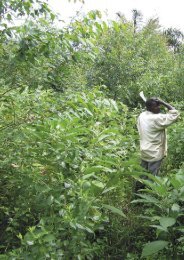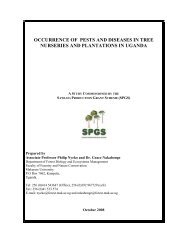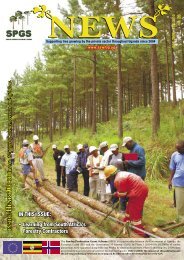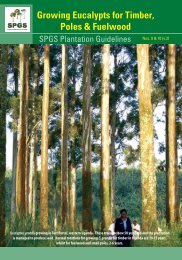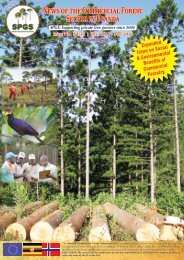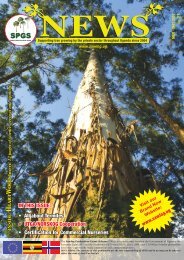download - SPGS
download - SPGS
download - SPGS
You also want an ePaper? Increase the reach of your titles
YUMPU automatically turns print PDFs into web optimized ePapers that Google loves.
HeartWood No. 1 (2009)<br />
Even if there was universal agreement that<br />
human nutrition should have priority in<br />
decisions regarding the use to which land is put,<br />
there remains the problem of land adequacy,<br />
as already highlighted in the reference above<br />
to the estimates and opinions of Professor<br />
Rattan Lal. Moreover, there is the important<br />
matter of how the required productivity from a<br />
reduced area of land can be attained without<br />
an adequate supply of phosphate fertilizers.<br />
Certainly, it would seem that a second “green<br />
revolution” will be necessary if food, feed and<br />
fibre supplies are to be available in sufficient<br />
quantities to improve the lives of all of the<br />
world’s inhabitants. Lest this view is seen as<br />
neo-Malthusian, permit me to remind readers<br />
of what appears to be the almost universal<br />
prevalence of out-of-sight, out-of-mind<br />
attitudes in this matter. In 1996, the FAO World<br />
Food Summit 12 resulted in a consensus target of<br />
halving the global number of undernourished<br />
people by the year 2015 4 . Since, the number<br />
has progressively increased to now include<br />
almost one billion people. That is hardly an<br />
indication of genuine humanitarian concern.<br />
Rather, it is almost certainly a reflection of<br />
the sad lack of political leadership within the<br />
global community. Tragedy is transformed to<br />
obscenity with the indication that, over the<br />
same period in which the resolve of the World<br />
Food Summit to save lives so conspicuously<br />
failed, global expenditure on armaments to<br />
take lives increased by 45 % to the annual level<br />
of USD 1.4 trillion in 2007 13 .<br />
The Plantations of the Future<br />
Let me begin on this rather speculative topic<br />
by re-affirming that plantations represent<br />
an entirely legitimate land-use. Under best<br />
management practices, their production of wood<br />
should not be seen as different to other forms<br />
of cropping. Moreover, they can make three<br />
significant contributions to partial alleviation<br />
of possibly the gravest of the global problems<br />
highlighted above, namely global warming :<br />
• plantations sequester carbon by<br />
photosynthetic extraction of carbon dioxide<br />
from the atmosphere and the storage of<br />
carbohydrates in the above-ground and<br />
below-ground components of their biomass.<br />
This sequestration can be augmented<br />
through adoption of specific management<br />
techniques and it can be attenuated in<br />
long-life wood products from plantations,<br />
such as furniture ;<br />
• plantations provide wood (both primary<br />
wood and residues) which can be converted<br />
into a variety of solid, liquid and gaseous<br />
fuels. Technological advances promise a<br />
future in which wood-based fuels could<br />
eliminate bio-fuels based on food or feed<br />
raw materials ; but, most importantly,<br />
• plantations provide wood with strong<br />
Figure 3. : (from The Economist) : Use as a<br />
bio-fuel has driven up the price of palm-oil as<br />
a cooking oil and the affordability of this small<br />
weekly purchase for many families in India is<br />
questionable.<br />
potential to substitute for that harvested<br />
from native forests, an activity which<br />
– unfortunately – is too often associated<br />
with degradation and destruction, reflecting<br />
some combination of ignorance, institutional<br />
weakness or malfeasance. This degradation<br />
and destruction of native forests may<br />
contribute 20 % or more of global man-made<br />
carbon dioxide emissions 14 ;<br />
However, in the future, it is difficult to see how<br />
conventional plantation cropping can compete<br />
for any land that can be used for growing food,<br />
feed and fibre for human consumption. Such<br />
is no more than reflection of what appears to<br />
be the looming, acute scarcity of such land.<br />
Indeed, it is not unreasonable to suggest the<br />
possibility that future governments may feel<br />
obligated to legislate to prevent dwindling<br />
areas of arable land being used for purposes<br />
other than supplying these essentials for human<br />
existence.<br />
Thus, I suggest that the<br />
plantations of the future will<br />
either be located on lands not<br />
suited to food, feed and fibre<br />
production or be integrated<br />
with such production under a<br />
co-cropping system.<br />
The first option here is not a<br />
pleasant prospect. Perhaps<br />
inevitably, it would relegate<br />
plantations to lands which<br />
would :<br />
• deny achievement of<br />
potential productivity<br />
through edaphic and / or<br />
climatic limitations ; and /<br />
12<br />
Subsequently reinforced by Millennium Development Goal<br />
13<br />
Stockholm International Peace Research Institute : Armaments, Disarmament and International Security, 2008<br />
Figure 4. : A clonal plantation of E. tereticornis (aged 2 years)<br />
with a wheat co-crop in Punjab, India.<br />
14<br />
Source : IPCC reports, which also noted that this proportion is greater than that of the global transport industry. FAO states that 25 % of carbon dioxide emissions are attributable to deforestation. The<br />
organization also claims that global forests sequester 283 giga-tonnes (giga = 10^9) of carbon in their biomass alone, with one trillion (trillion = 10^12) tonnes stored in the total forest ecosystem. It estimates<br />
that destruction of global forests – concentrated in Asia, South America and Africa – releases about two billion (billion = 10^9) tonnes of carbon dioxide annually.<br />
15<br />
For definitions of the taungya system and some report on its application, please conduct a Google search.<br />
or,<br />
• increase costs of log products (through use<br />
of remote lands and / or those of steep<br />
topography).<br />
The second option of co-cropping is much<br />
more appealing. In my opinion, that it is both<br />
desirable and feasible is beyond doubt.<br />
The range of food, feed, fibre and fuel crops<br />
which can be grown in integrated systems<br />
with plantation trees is wide. Importantly,<br />
so too is the range of intensities with which<br />
the co-crop can be applied in the integrated<br />
system. For example, grazing cattle in many<br />
Eucalypt plantations in Uruguay – a low<br />
intensity co-cropping – seems not to diminish<br />
wood productivity per gross hectare of land<br />
used. Simultaneously, it minimizes fire risks.<br />
Another low intensity co-cropping occurs under<br />
the trees-on-farms concept where it can be<br />
demonstrated that planting up to 10 % of a<br />
pasture area at a high stand density results<br />
in no loss of live-weight beef productivity per<br />
gross hectare because of the beneficial effects<br />
of the shelter provided. Any periodic revenue<br />
from sales of wood produced by the plantations<br />
is a bonus.<br />
Not surprisingly, where productive arable land<br />
per caput is already a scarce resource, integration<br />
of plantation trees with co-crops for food, feed,<br />
fibre and fuel is already extensively practiced.<br />
In both Asia and Africa, the long-practised<br />
taungya silvicultural system is well distributed,<br />
though not always successfully 15 . More<br />
recently, reduced stand densities and greater<br />
continuity of co-cropping have been features of<br />
integrated systems applied over large areas in,<br />
for example, China, Thailand and India. This<br />
photograph shows one Indian system. I shall<br />
report on Eucalyptus in India – the nation with<br />
the world’s largest area of Eucalypt plantations 16<br />
– in a future contribution.<br />
5



